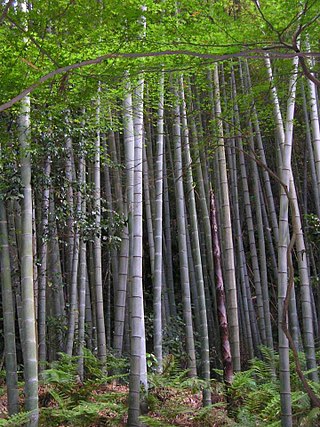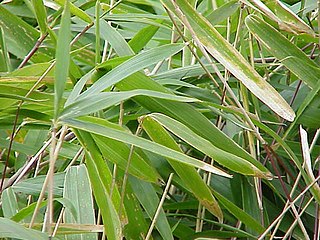
Bamboos are a diverse group of mostly evergreen perennial flowering plants making up the subfamily Bambusoideae of the grass family Poaceae. Giant bamboos are the largest members of the grass family, in the case of Dendrocalamus sinicus individual culms reaching a length of 46 meters, up to 36 centimeters in thickness and a weight of up to 450 kilograms. The internodes of bamboos can also be of great length. Kinabaluchloa wrayi has internodes up to 2.5 meters in length. and Arthrostylidium schombergkii with lower internodes up to 5 meters in length, exceeded in length only by papyrus. By contrast, the culms of the tiny bamboo Raddiella vanessiae of the savannas of French Guiana are only 10–20 millimeters in length by about two millimeters in width. The origin of the word "bamboo" is uncertain, but it probably comes from the Dutch or Portuguese language, which originally borrowed it from Malay or Kannada.

Bulbophyllum is a genus of mostly epiphytic and lithophytic orchids in the family Orchidaceae. It is the largest genus in the orchid family and one of the largest genera of flowering plants with more than 2,000 species, exceeded in number only by Astragalus. These orchids are found in diverse habitats throughout most of the warmer parts of the world including Africa, southern Asia, Latin America, the West Indies, and various islands in the Indian and Pacific Oceans. Orchids in this genus have thread-like or fibrous roots that creep over the surface of trees or rocks or hang from branches. The stem is divided into a rhizome and a pseudobulb, a feature that distinguished this genus from Dendrobium. There is usually only a single leaf at the top of the pseudobulb and from one to many flowers are arranged along an unbranched flowering stem that arises from the base of the pseudobulb. Several attempts have been made to separate Bulbophyllum into smaller genera, but most have not been accepted by the World Checklist of Selected Plant Families.

Carpet sharks are sharks classified in the order Orectolobiformes. Sometimes the common name "carpet shark" is used interchangeably with "wobbegong", which is the common name of sharks in the family Orectolobidae. Carpet sharks have five gill slits, two spineless dorsal fins, and a small mouth that does not extend past the eyes. Many species have barbels.

Pleioblastus is an East Asian genus of monopodial bamboos in the grass family Poaceae. They are native to China and Japan, and naturalized in scattered places in Korea, Europe, New Zealand, and the Western Hemisphere.

Drepanostachyum is an Asian genus of medium-sized mountain clumping bamboos in the grass family. They are native to China, Indochina, and the Indian Subcontinent.

Thamnocalamus is a genus of clumping bamboo in the grass family. These species are found from the Himalayas as well as Madagascar and Southern Africa.

The bamboo lemurs or gentle lemurs are the lemurs in genus Hapalemur. These medium-sized primates live exclusively on Madagascar.

Yushania is a genus of bamboo in the grass family.

Arundinarieae is a tribe of bamboo in the grass family (Poaceae) containing a single subtribe, Arundinariinae, and 31 genera. These woody bamboos occur in areas with warm temperate climates in southeastern North America, Subsaharan Africa, South Asia and East Asia. The tribe forms a lineage independent of the tropical woody bamboos (Bambuseae) and the tropical herbaceous bamboos (Olyreae).
Neomicrocalamus is an Asian genus of bamboo in the grass family.

Acidosasa is a genus of East Asian bamboo in the grass family.

Fargesia is a genus of flowering plants in the grass family. These bamboos are native primarily to China, with a few species in Vietnam and in the eastern Himalayas. Some species are cultivated as ornamentals, with common names including umbrella bamboo and fountain bamboo.
Ferrocalamus, or iron bamboo, is a genus of Chinese bamboo in the grass family. endemic to China. The plant is known only from southern Yunnan, at elevations of 900 to 1,200 m above sea level.
Gelidocalamus is a genus of small to medium-sized bamboos in the grass family, native primarily to the mountains of eastern China, although one species (G. kunishii) is native to Taiwan and to the Nansei-shoto region in Japan.
Candy stripe may refer to:
Filgueirasia is a genus of Brazilian bamboo in the grass family.
Bashania is a genus of East Asian bamboo in the grass family, native to China and Vietnam.
- Bashania abietinaT.P.Yi & L.Yang – Sichuan
- Bashania fansipanensisT.Q.Nguyen – Vietnam
- Bashania fargesii(E.G.Camus) Keng f. & T.P.Yi – Gansu, Hubei, Shaanxi, Sichuan
- Bashania qingchengshanensisKeng f. & T.P.Yi – Sichuan
Sasamorpha is a genus of East Asian bamboo in the grass family.
- Sasamorpha borealis(Hack.) Nakai – Korea, Japan, Sakhalin
- Sasamorpha hubeiensisC.H.Hu – Hubei, Jiangxi
- Sasamorpha oshidensis(Makino & Uchida) Nakai – Japan
- Sasamorpha qingyuanensisC.H.Hu – Zhejiang
- Sasamorpha sinica(Keng) Koidz. – Anhui, Zhejiang
Pseudosasa cantorii is a species of bamboo originally from China. It can grow up to a height of 1.5–2 meters.
Yi-Li Keng was a Chinese botanist, specializing in the study of grasses, particularly the tribe Triticeae of the Poaceae.















